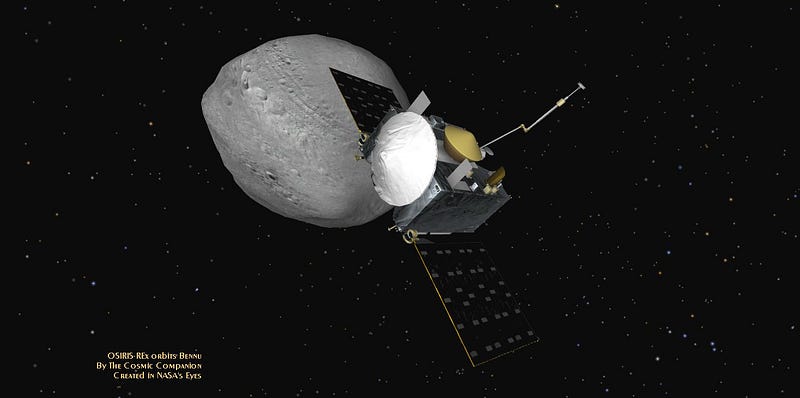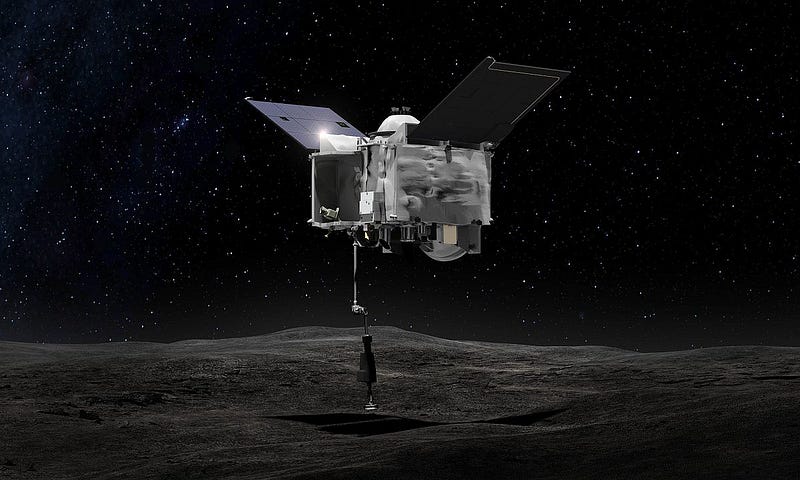Bennu Asteroid: Insights from OSIRIS-REx's Discoveries
Written on
Chapter 1: An Active Asteroid Unveiled
Recent observations from the OSIRIS-REx spacecraft have uncovered intriguing behaviors of the Bennu asteroid, particularly its tendency to release material into space. This phenomenon prompts an investigation into the underlying mechanisms and its implications for NASA's mission.
As Bennu orbits between Mars and Jupiter, it is subjected to constant impacts from smaller debris. These collisions can dislodge material from its surface, while uneven heating from the Sun during its rotation can also contribute to this shedding. Although most of the expelled fragments return to the asteroid, a minority escape the gravitational pull and venture into interplanetary space.

The OSIRIS-REx spacecraft has provided unprecedented insights into Bennu since its arrival in January 2019. Initial signs of material being ejected were observed soon after the spacecraft reached the asteroid.
Using periodic images of background stars for navigation, similar to ancient navigators, researchers noted an unexpected number of light points in the data. Carl Hergenrother from the Lunar and Planetary Laboratory at the University of Arizona remarked, “As I reviewed the star formations, I was surprised by the density of light. Initially, I thought it was a distinct cluster, but it turned out to be debris escaping from Bennu.”
Upon further analysis, it was determined that these 'stars' were actually small particles leaving the asteroid at an average velocity of 20 centimeters per second, roughly half the pace of a walking beetle. The fastest debris recorded moved at around three meters per second, equating to just over 6.5 MPH.
“The most recognized causes of these ejection events include cracking due to thermal stress and impacts from meteoroids. Additionally, ricochet effects, where a particle rebounds after striking the surface, can occur. Bennu, therefore, is categorized as an ‘active asteroid,’ a designation previously reserved for comets,” the researchers explain.
The largest fragments thrown off Bennu are about six centimeters (2.5 inches) wide, which pose no significant risk to the spacecraft due to their low speeds. Among the 668 particles analyzed, most measured less than one centimeter (0.4 inch).

As Hergenrother noted, “Despite the asteroid expelling numerous particles, the vast emptiness of space makes the probability of a collision with the spacecraft extremely low. Even in the rare event of impact, most particles are neither large nor fast enough to inflict damage.”
Bennu completes a rotation approximately every four hours and 18 minutes. As it warms on one side and cools on the other, thermal stress causes material to be ejected. On average, Bennu releases one or two pebbles each day, primarily during the afternoon and early evening. Most of these eventually fall back to the asteroid's surface.
This first video, "OSIRIS-REx Observes an Asteroid in Action," showcases the dynamic activity of Bennu as observed by the OSIRIS-REx spacecraft.
One intriguing instance involved a particle that orbited Bennu for a week before returning to its surface. These ejection events provide researchers with valuable insights into the asteroid's internal structure, revealing areas of varying density.
Launched in September 2016, OSIRIS-REx took its initial image of Bennu in August 2018. The spacecraft is scheduled for a touch-and-go maneuver to collect samples, with a return to Earth planned for March 2021. This research highlights that asteroids like Bennu are not merely inert objects; they are active and evolving as they move through the solar system.
The findings regarding Bennu's activity are detailed in the Journal of Geophysical Research: Planets.
James Maynard, the founder and publisher of The Cosmic Companion, resides in Tucson with his wife Nicole and their cat, Max.
Enjoyed this article? Join us on The Cosmic Companion Network for our podcast, weekly videos, informative newsletter, and more!
Chapter 2: The Journey of OSIRIS-REx
The second video, "OSIRIS-REx: To Bennu and Back - NASA, Asteroids, and a Lifelong Dream," delves into the mission's objectives and its significance in our understanding of asteroids.